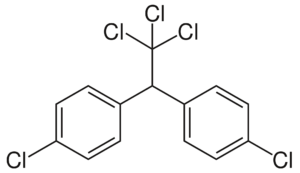DDT

DDT (dichlorodiphenyltrichloroethane) is an organochloride that was routinely used as an insecticide between the 1940s and 1980s. It was first synthesized in 1874, but its insecticidal properties weren’t discovered until 1939. DDT was initially used during World War II to control the spread of typhus and malaria. It was introduced to the agricultural market in the 1950s, where it rapidly became one of the most popular commercial insecticides. At its peak usage, over 40,000 tonnes (per year) of DDT were introduced to the environment.
By the mid-1940s, concerns arose regarding the environmental impact of DDT use. Evidence emerged that proved DDT to be a persistent organic pollutant. It is absorbed by soil, and has a half-life of up to thirty years. As DDT breaks down it impacts terrestrial organisms, particularly predatory birds. The organochloride bioaccumulates in each level of a trophic chain. Raptors are apex predators, and are exposed to pollutants by consuming animals in lower trophic levels. The toxins are stored in their fatty tissue. This leads to egg shell thinning, which causes lower birth rates in many bird species due to egg breakage and embryo death.
The environmental impact of DDT is not limited to birds. It is a hydrophobic compound, and does not dissolve in water. This means fish, crayfish, daphnids, and shrimp are exposed to DDT when it is used near aquatic ecosystems. Even humans accumulate DDT in their fatty tissue. There is limited evidence to show how directly the substance impacts human health, but it may cause reproductive issues and some cancers. Blood tests taken by the CDC in 2005 found measureable levels of DDT in nearly all human blood samples, and the FDA still finds traces of DDT in food tests.

Steps to ban DDT began around 1950, but it wasn’t until author and naturalist Rachel Carson published her seminal work Silent Spring that proper reform began. The book was beautifully written, accessible in its prose, but scientifically charged. Carson explained the way DDT works, how it impacts an environment, and the ramifications of its continued use. Silent Spring drew the issue into the public eye, and is credited as a catalyst for the United States environmental movement.
In 1971 the U.S. District Court of Appeals demanded that the Environmental Protection Agency begin deregistering DDT as a usable insecticide. Between 1971 and 1972 the EPA held a number of hearings where scientists argued the pros and cons of DDT use. Ultimately the hearings ruled that DDT use must be discontinued, and the use of the organochloride was phased out.
In 2004 The Stockholm Convention authorized a global ban on DDT. Use is now restricted to mosquito control in malaria prone countries.
Back to Environmental Crimes
Back to Crime Library
|
|
|

